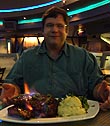|
|
 
|
|
Author
|
Topic: sound proofing techniques?
|
|
|
|
|
|
|
Rick Long
Jedi Master Film Handler
Posts: 759
From: Toronto, Ontario, Canada
Registered: Nov 1999
|
 posted 07-06-2000 10:22 PM
posted 07-06-2000 10:22 PM




The latest istallation I did, featured non-openable port-glass that was sealed with silicone (or other caulking) around the glass. Fortunately, all auditoriums featured stadium seating, so cleaning the auditorium side of the glass was not too big a deal (although the observation port can be a bit of a bitch to reach in some cases).
At first, I was not impressed, but as the installation progressed, I noticed two things.
(1) The booth stayed a lot cleaner during the installation.
(2) Sound transferance from the booth to the auditorium was reduced considerably to the point where, when holding a sound meter while doing auditorium level sets, and communication was necessary with the guy in the booth, we had to run up to the port and shout loudly at the glass to be heard on the other side (usually only necessary to avoid confusion with surround level settings for EX).If it is practical in your situation, an inexpensive solution might be to silicone around the glass edges of all openings to the auditoriums.
| IP: Logged
|
|
John Pytlak
Film God

Posts: 9987
From: Rochester, NY 14650-1922
Registered: Jan 2000
|
 posted 07-07-2000 07:09 AM
posted 07-07-2000 07:09 AM





Kelmar Systems markets double-pane ports:
http://www.kelmarsystems.com/page24.html Goldberg Brothers also sells port systems:
http://goldbergbrothers.uswestdex.com/goldbergbrothers/Page2.html Port glass should be optical quality, with anti-reflection coatings. It should be angled to the projection beam, such that it does not reflect light back into the lens. If double panes are used for acoustic isolation, they should NOT be parallel to each other, to avoid contrast-reducing re-reflection between the two panes. ------------------
John P. Pytlak, Senior Technical Specialist
Worldwide Technical Services, Entertainment Imaging
Eastman Kodak Company
Research Labs, Building 69, Room 7419
Rochester, New York, 14650-1922 USA
Tel: 716-477-5325 Fax: 716-722-7243
E-Mail: john.pytlak@kodak.com
| IP: Logged
|
|
|
|
|
|
|
|
Rick Long
Jedi Master Film Handler
Posts: 759
From: Toronto, Ontario, Canada
Registered: Nov 1999
|
 posted 07-07-2000 06:32 PM
posted 07-07-2000 06:32 PM




Yes, at first we were indeed tempted to smash a hole in the wall where it would not be noticed. Instead cooler heads prevaled, and we used the mike (p.a.) line going from the sound rack to back-stage. A few dozen feet of shielded cable and a quarter-pound of aligator clips later, we connected the mike box from the auditorium to the RTA. I did talk to one of the architects, who paid a visit during the installation, and I got at least a promise of consideration about installing a piece of 2" PVC pipe, with threaded closeable ends, through the wall on fuure installations, such that the auditorium end would be behind a seat and generally invisible to the audience. Whether this matter was forgotten before he even left the building remains to be seen.
| IP: Logged
|
|
|
|
All times are Central (GMT -6:00)
|
|
Powered by Infopop Corporation
UBB.classicTM
6.3.1.2
The Film-Tech Forums are designed for various members related to the cinema industry to express their opinions, viewpoints and testimonials on various products, services and events based upon speculation, personal knowledge and factual information through use, therefore all views represented here allow no liability upon the publishers of this web site and the owners of said views assume no liability for any ill will resulting from these postings. The posts made here are for educational as well as entertainment purposes and as such anyone viewing this portion of the website must accept these views as statements of the author of that opinion
and agrees to release the authors from any and all liability.
|

 Home
Home
 Products
Products
 Store
Store
 Forum
Forum
 Warehouse
Warehouse
 Contact Us
Contact Us




 Printer-friendly view of this topic
Printer-friendly view of this topic
















